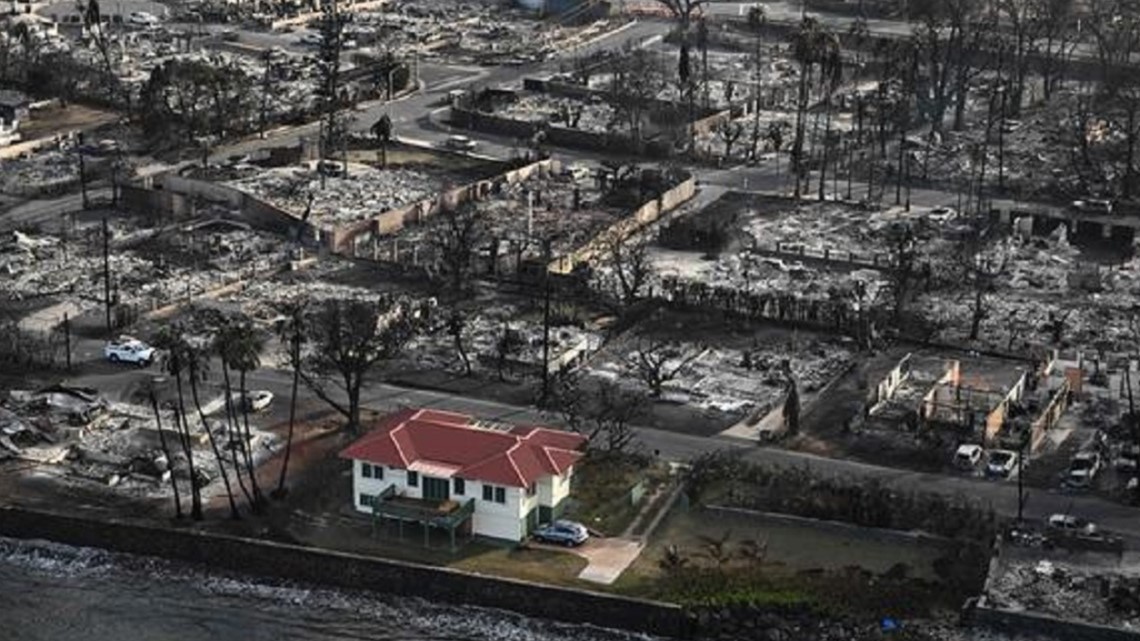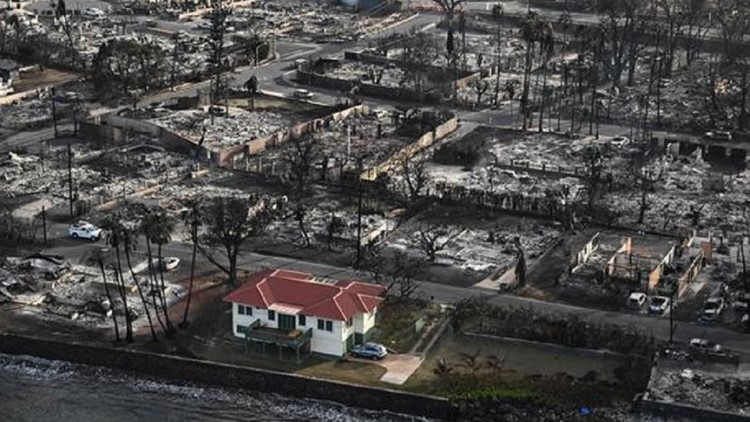LAHAINA, Hawaii — On a section of Front Street in the town of Lahaina, every structure has been charred and replaced with squares of ash – except one. Right along the sea wall lies a single house with a red roof, green porch and a seemingly unharmed vehicle in a largely unscathed driveway.
And the building has been around for nearly a century.
Maui county records show the house at its current location at 271 Front Street is 81 years old, and sits on more than 11,000 square feet of property at 271 Front Street in the city that was once the long-standing capital of the Hawaiian Kingdom. But the building has been in the community for even longer.
According to the Historic Hawaii Foundation, the house has been nominated to be designated a historic site, as it was formerly the home of the Pioneer Mill Company/Lahaina Ice Company Bookeeper's House. The nomination form for the historic places registry says that it was built in 1925, is distinctive to the times it was built and is "associated with events that have made a significant contribution to the broad patterns" of Hawaiian history.
The house was home to bookkeepers or accountants "who played important roles in the development of the Pioneer Mill Co. and Lahaina Ice Co.," the form says, "and its delivery of ice and aerated (soda) water along with electrical service and related products to Lahaina customers during the early-mid-twentieth century." One of its longtime residents, Frank A. Alameda, was a Lahaina Ice Co. employee turned Hawaii National Guardsman who became the namesake of the Hawai'i National Guard Armory in Wailuku.
It was eventually moved to its current Front Street location in 1942, and earlier this year, the three-bedroom, three-bathroom house was valued at more than $3.5 million.
Now, in a land of rubble, its worth is so much more.
"It looks like it was photoshopped in," Trip Millikin, who owns the house, told local outlet Honolulu Civil Beat. Records show he and his wife Dora Millikin bought the house in May 2021 after what he told the Civil Beat was a long time of bicycling by.
"The house was an absolute nightmare, but you could see the bones of it," he said, saying that the local historic building suffered from a rotting exterior.
So when they finally got the chance to buy it, they did, and completely revamped the property. And doing that may have just been the thing that ensured its survival in the fire.


Millikin told Civil Beat that the house was built of California redwood, a tree known for its "superpower" of being fire resistant, according to the National Park Service. The bark of these trees contains tannic acid, which helps their bark stay safe from flames.
But according to Civil Beat, the house next door was also made of the same wood – and burned down. So what exactly set this one apart?
Millikin told the outlet that when they were doing renovations, they also put it in a commercial-grade steel roof and dug out old landscaping to replace it with river stones about a meter around the house. The latter is what likely made the biggest difference in the house's ability to withstand the flames, Michael Wara, director of the Climate and Energy Policy Program at the Stanford Wood Institute for the Environment, told Civil Beat.
That's because of embers.
In the immediate home ignition zone – the area up to 5 feet around your home – using crushed stone or gravel is a vital part of reducing the risk of the structure being set ablaze. According to the National Fire Protection Association, reducing flammable vegetation in this area is crucial. The group also says metal roofing, removing dead debris or flammable materials from porch areas and using fire-resistant house siding can help homes withstand fires.
Without the proper precautions, houses can "start catching each other on fire," Wara told Civil Beat. "If enough of the homes have that kind of preparation then that chain reaction doesn't get started."
Millikin was in Massachusetts when the Aug. 8 fire broke out in Lahaina. He had been told that his home would likely not make it. But the next day, he received a picture – in the middle of dozens of piles of ash stood his home, largely untouched. Suddenly, he had what some are dubbing on social media as a "miracle house," often seen in the aftermath of fires in places like California.
"That's our house," he told Civil Beat. "... We started crying. I felt guilty. We still feel guilty."
But that guilt isn't going to be harped over. Instead, he and his wife are using it as a symbol of hope amid the destruction that has killed more than 100 and left more than 800 missing.
"Let's rebuild this together," Millikin said. "This house will become a base for all of us. Let's use it."


